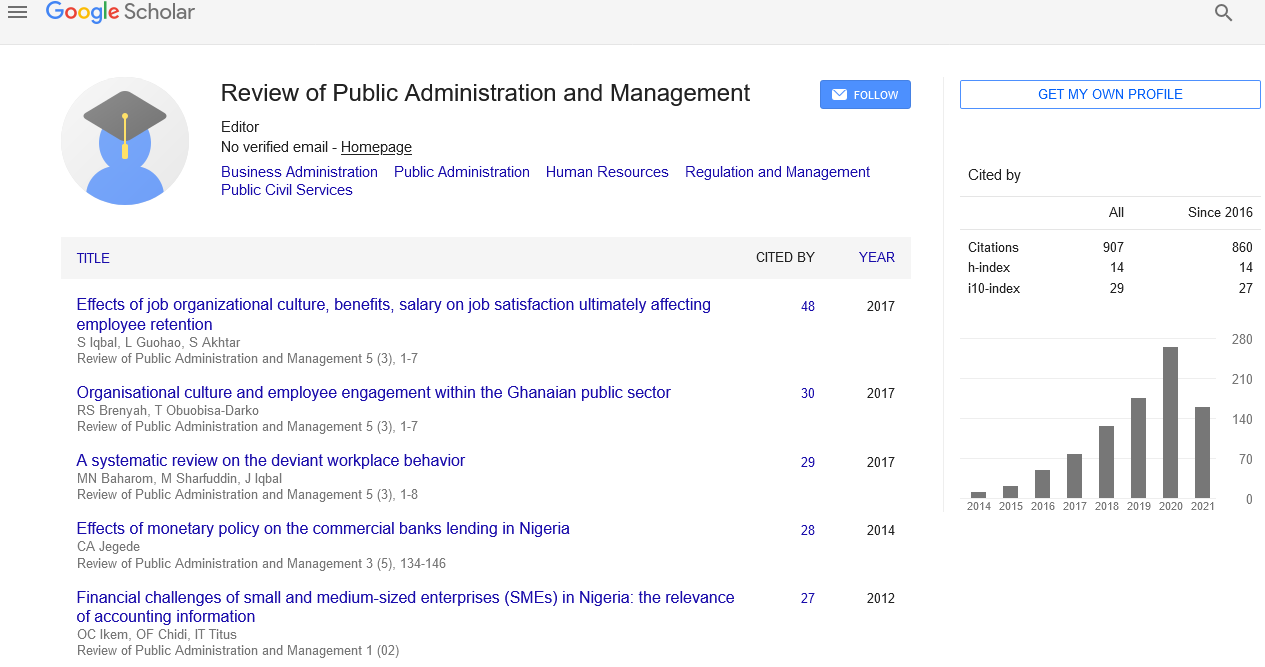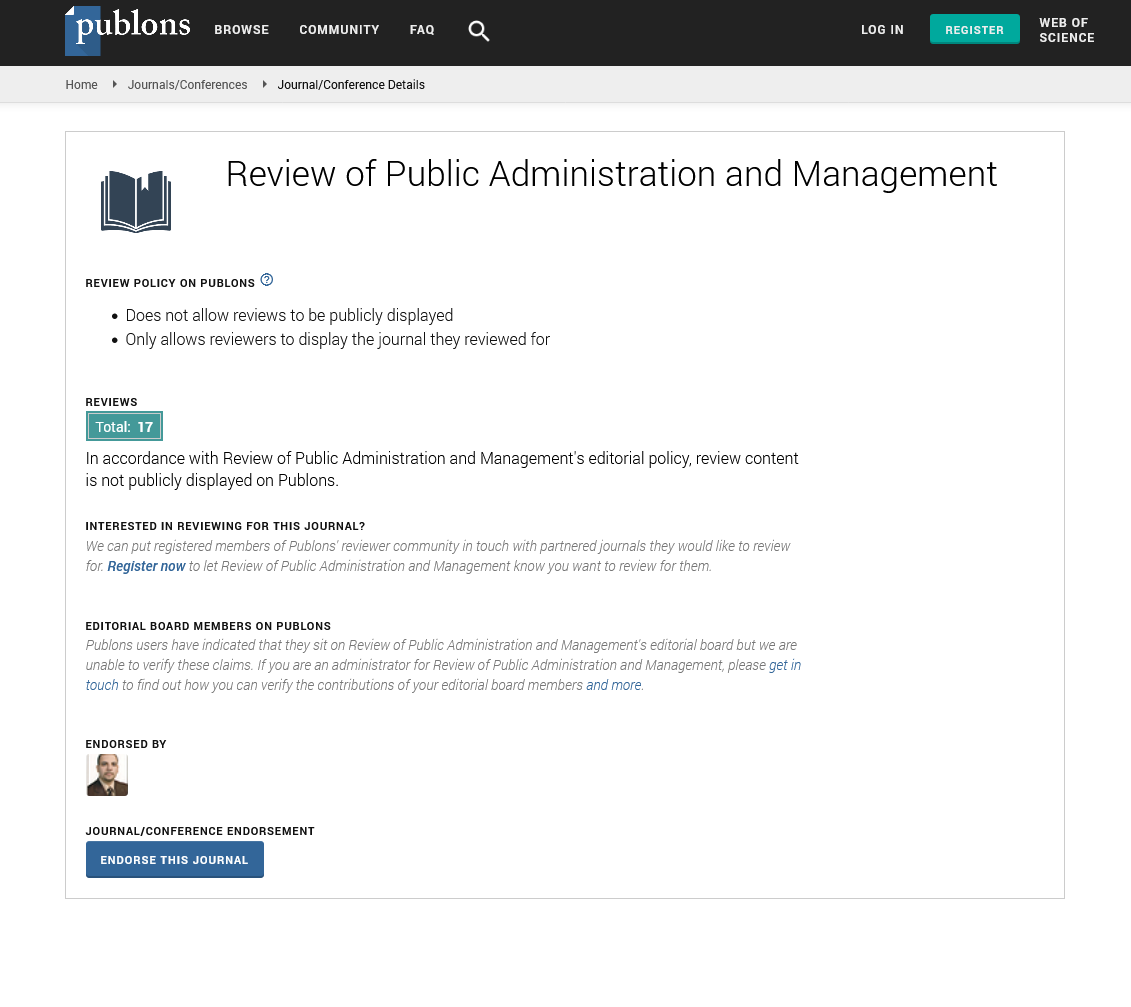Indexed In
- CiteFactor
- RefSeek
- Directory of Research Journal Indexing (DRJI)
- Hamdard University
- EBSCO A-Z
- Scholarsteer
- Publons
- Euro Pub
- Google Scholar
Useful Links
Share This Page
Journal Flyer

Open Access Journals
- Agri and Aquaculture
- Biochemistry
- Bioinformatics & Systems Biology
- Business & Management
- Chemistry
- Clinical Sciences
- Engineering
- Food & Nutrition
- General Science
- Genetics & Molecular Biology
- Immunology & Microbiology
- Medical Sciences
- Neuroscience & Psychology
- Nursing & Health Care
- Pharmaceutical Sciences
Perspective - (2021) Volume 9, Issue 10
Public Human Resource Management
Rebecca Ferguson*Received: 09-Oct-2021 Published: 30-Oct-2021, DOI: 10.35248/2315-7844.21.9.309
Perspective
HRM has a substantial effect on public sector reform, according to this summary of HRM in the public sector. The bureaucratic and managerial models of public sector operation and activity are contrasted in order to determine how each model conceptualises employment and organisational difficulties. It is investigated how structural, policy, and organisational changes affect public sector employment and working conditions. While changes in the public sector have had a significant impact on public sector employees and the conditions in which they work over the last two decades, there has been little attention paid to the specific field of Human Resource Management research and academic inquiry in relation to the public sector. Furthermore, contemporary HRM texts frequently ignore or provide only a cursory mention of HRM in the public sector, instead appropriating a firm's business model as the broad backdrop for HRM studies The article begins with defining and describing the scope and characteristics of human resource management.
The article begins by explaining and analysing the traditional public administration model before moving on to the role and function of staff within this bureaucratic architecture. The origins of today's public management model are explored in order to highlight the extent and character of public sector change. The integration of HRM and public management is in line with efforts to build a systematic response to public sector reform and restructuring initiatives by increasing employee and operational efficiencies while reducing government spending.
The centralfocus of Human Resource Managementis'managing people within the employer-employee relationship, which entails marshalling the productive ability of an organization's members (Stone 1995). HRM, according to Stone (1995), is concerned with the "acquisition, development, reward and motivation maintenance and departure" of employees, and typical areas of concern include HR planning and capability audits, employee recruitment and selection, skill development and training, career progression, performance appraisal, determining employment conditions, and compensation and reward. HRM is also concerned with understanding and interpreting, according to Wright and Ferris (1996). HRM's relevance to public-sector enterprises has therefore been proved.
Organizations in the public sector must hire, develop, and train personnel, as well as establish payment systems, establish employment conditions, and construct a consistent set of employment policies. However, the public sector's unique characteristics, such as a focus on public interest outcomes rather than private interests, may introduce a degree of complexity that is difficult to reconcile with HRM as a strategic partner in achieving organisational competitiveness and economic objectives.
The old model of personnel administration was supplanted by the application of HRM concepts in the public sector. HRM was argued to have been introduced in the public sector as the sector shifted from a "rule-bound" to a "performance-based" culture. HRM was adopted at the same time as a massive reorganisation and reform effort in the public sector. Managerial goals of increased efficiency are said to be attained by employing effective human resource strategies suggested by HRM concepts. As a result of the implementation of New Public Management (NPM), managers may have been able to acquire or build sophisticated HRM skills. Over time, the public sector developed a distinct approach to HRM, which included numerous innovations that provided employees with substantial rights and privileges. The public sector has long been regarded as a "model employer," with working conditions at the forefront of labour reform and innovation. The model employer concept incorporated best practises and was said to set an example for the private sector in terms of treating employees fairly and offering decent working circumstances, such as high job security, superior leave rights, and large pensions.
A bureaucratic employment policy mirrored the operation of Weberian methods and principles of rule-governed rational conduct in the traditional public sector model. To ensure that judgments and actions were consistent, institutionalised, and systematically handled activities through a pre-defined application of rules and processes, the administrative system was subjected to a bureaucratization of procedures. The public sector had uniform wages and conditions, therefore there could be no fluctuation in pay based on performance; instead, pay was determined by the job or position. Job positions were restricted, task-focused, and heavily routinized, and administration was based on Taylorist work practises of isolating constituent elements of work to create economies of scale. Promotion was based on strict seniority or duration of service.
Citation: Ferguson R (2021) Public Human Resource Management. Review Pub Administration Manag. 9:309
Copyright: © 2021 Ferguson R. This is an open-access article distributed under the terms of the Creative Commons Attribution License, which permits unrestricted use, distribution, and reproduction in any medium, provided the original author and source are credited.


